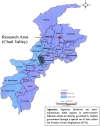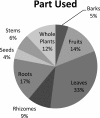An ethnobotanical study of medicinal plants in high mountainous region of Chail valley (District Swat- Pakistan)
- PMID: 24739524
- PMCID: PMC4022037
- DOI: 10.1186/1746-4269-10-36
An ethnobotanical study of medicinal plants in high mountainous region of Chail valley (District Swat- Pakistan)
Abstract
Background: This paper represents the first ethnobotanical study in Chail valley of district Swat-Pakistan and provides significant information on medicinal plants use among the tribal people of the area. The aim of this study was to document the medicinal uses of local plants and to develop an ethnobotanical inventory of the species diversity.
Methods: In present study, semi-structured interviews with 142 inhabitants (age range between 31-75 years) were conducted. Ethnobotanical data was analyzed using relative frequency of citation (RFC) to determine the well-known and most useful species in the area.
Results: Current research work reports total of 50 plant species belonging to 48 genera of 35 families from Chail valley. Origanum vulgare, Geranium wallichianum and Skimmia laureola have the highest values of relative frequency of citation (RFC) and are widely known by the inhabitants of the valley. The majority of the documented plants were herbs (58%) followed by shrubs (28%), trees (12%) and then climbers (2%). The part of the plant most frequently used was the leaves (33%) followed by roots (17%), fruits (14%), whole plant (12%), rhizomes (9%), stems (6%), barks (5%) and seeds (4%). Decoction was the most common preparation method use in herbal recipes. The most frequently treated diseases in the valley were urinary disorders, skin infections, digestive disorders, asthma, jaundice, angina, chronic dysentery and diarrhea.
Conclusion: This study contributes an ethnobotanical inventory of medicinal plants with their frequency of citations together with the part used, disease treated and methods of application among the tribal communities of Chail valley. The present survey has documented from this valley considerable indigenous knowledge about the local medicinal plants for treating number of common diseases that is ready to be further investigated for biological, pharmacological and toxicological screening. This study also provides some socio-economic aspects which are associated to the local tribal communities.
Figures






References
-
- Shinwari ZK. Medicinal plants research in Pakistan. J Med Plants Res. 2010;4:161–176.
-
- Ugulu I, Baslar S, Yorek N, Dogan Y. The investigation and quantitative ethnobotanical evaluation of medicinal plants used around Izmir Province, Turkey. JMPR. 2009;3:345–367.
MeSH terms
LinkOut - more resources
Full Text Sources
Other Literature Sources

